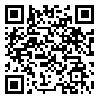Volume 73, Issue 4 (July 2015)
Tehran Univ Med J 2015, 73(4): 271-280 |
Back to browse issues page
1- School of Allied Medical Sciences, Tehran University of Medical Sciences, Tehran, Iran.
2- Research Center for Biomedical Technologies and Robotics (RCBTR), Tehran University of Medical Sciences, Tehran, Iran. ,arabalibeik@tums.ac.ir
3- Department of Cardiology, Rajaei Cardiovascular, Medical and Research Center, Iran University of Medical Sciences, Tehran, Iran.
2- Research Center for Biomedical Technologies and Robotics (RCBTR), Tehran University of Medical Sciences, Tehran, Iran. ,
3- Department of Cardiology, Rajaei Cardiovascular, Medical and Research Center, Iran University of Medical Sciences, Tehran, Iran.
Abstract: (4951 Views)
Background: Warfarin is the most common oral anticoagulant. This drug is used for the prevention and treatment of thromboembolic patients. It is difficult for physician to predict the results of warfarin prescriptions because there is narrow boundary between therapeutic range and complications of warfarin. Therefore drug dose adjustment is normally performed by an expert physician. Decision support systems that use extracted knowledge from experts in the field of drug dose adjustment would be useful in reducing medical errors, especially in the clinics with limited access to experts. The aim of this study was to propose a method for boosting the maintenance dose of warfarin for a maximum period of three days to eliminate disruptions in International Normalized Ratio (INR).
Methods: In a retrospective study, from December 2013 to February 2014 in Shahid Rajaee Heart Center, Tehran, Iran, 84 patients with International Normalized Ratio below (INR) the therapeutic range was selected who was undergone a boosting dose during three days. Patients with unstable maintenance dose were excluded from the study. In this study, data from 75 patients receiving warfarin therapy were used for developing and evaluation of the proposed model. The INR target range for 37 patients out of remaining 75 cases was between 2.5 and 3.5, while for 38 patients the intended INR range was between 2 and 3. A separate fuzzy model was designed for each of the above-mentioned therapeutic ranges.
Results: The recommended dose for 37 patients having INR therapeutic range of 2.5 to 3.5 has mean absolute error and root mean squared error of 1.89 and 2.78 respectively for three days. These error rates are 1.97 and 2.88 respectively for 38 patients who are in therapeutic range 2 to 3.
Conclusion: The results are promising and encourage one to consider this system for more study with the aim of possible use as a decision support system in the future.
Keywords: anticoagulants, clinical decision support system, fuzzy logic, international normalized ratio, retrospective studies, warfarin
Type of Study: Original Article |
| Rights and permissions | |
 |
This work is licensed under a Creative Commons Attribution-NonCommercial 4.0 International License. |


